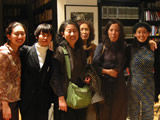Special EssaysEditor: Takako Arai
- A city alive with poetry
From the Festival of Contemporary Japanese Women Poets in New York (November, 2006)
Takako Arai
Translation by Richard Webb
November 15-17, the Festival of Contemporary Japanese Women Poets, a series of readings and panel discussions, was held in New York, and I, along with Sawako Nakayasu, Kyong-Mi Park, Ryoko Sekiguchi and Kiriu Minashita, was invited to attend. The festival is a project headed by Belladonna, an organization founded by Rachel Levitsky (photo provided by Levitsky) to help support women’s poetry.
Among the audience for this festival, which was performed by a relatively young generation of Japanese poets, were many leading avant-garde artists, including several New York poets and translators such as Charles Bernstein, choreographer Trisha Brown, painter Mimi Gross, and film director Holly Fisher. The three day event was full of passion and celebration, and also gave these Japanese poets the opportunity to promote the simultaneous release of their bilingual anthology, “Four From Japan”.
During these three days, I realized that poetry is alive in New York. In this city, aside from writing poetry, many poets are very eager to build a network where they can spread not just their own poems, but all poetry throughout society. For example, Bernstein has developed “PennSound”, an online archive of recorded readings of poets worldwide, and Tracy Grinnell, also a poet, manages Litmus Press, the joint publisher with Belladonna of this anthology. Since the use of computers has simplified such things as the construction of the network and editing, poets can have their own publishing company, which therefore allows them to release to the world poems or anthologies of their choosing.
Levitsky, who in the last seven years has planned nearly 60 poetry reading events for both domestic and foreign poets, says, “Through this organization, I have been able to participate in an ongoing conversation about poetry with people who are doing the most interesting work. So that I am involved with the questions of the day--how does poetry stay relevant beyond representation, beyond the experiments of modernism, and post-modernism. How are poets making meaning in these times”. In this city, being involved in building a concrete network based on this kind of awareness is typically part of a “poet’s” character. This inspires them to increase their potential as a poet, while reviving the anarchical power of free communication that poems naturally possess, which further spurs them on.
The fact that there is also a network of artists from other genres, who mix with these poets and are in touch with poetry, indicates the richness of this town. Thanks to the promising translator Sawako Nakayasu, the number of people buying this vivid and very experimental poetry collection is far exceeding expectations.
I discovered that a city can be alive with poetry, just as these American poets dream. There are plans to invite poets in America to come to Japan next year.
( the original Japanese text: Asahi Newspaper, evening edition (December 25, 2006))
Copyright © Mi’Te press. All rights reserved.
Designed by MOGRA DESIGN

